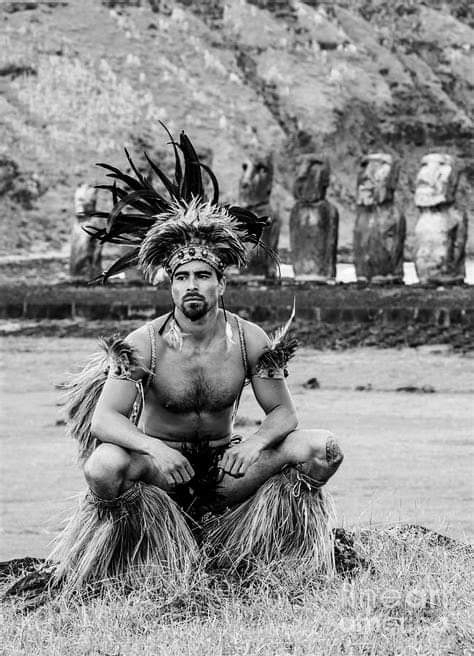The Rapa Nui people are the indigenous Polynesian inhabitants of Easter Island, also known as Rapa Nui, located in the southeastern Pacific Ocean. They are the easternmost Polynesian culture, with descendants of the original inhabitants making up about 60% of the current Easter Island population. A significant portion of the Rapa Nui population also resides in mainland Chile.
History of the Rapa Nui People
The Rapa Nui people are believed to have settled Easter Island between 300 and 1200 CE. While earlier estimates placed their arrival around 700-800 CE, more recent radiocarbon dating suggests a later arrival date. Genetic analysis of prehistoric skeletons confirms their Polynesian origin. However, further analysis in 2007 revealed genetic markers of European and Amerindian origin, suggesting possible interactions with these populations during or before the early 1800s.
Rapa Nui Culture
The Rapa Nui people have a rich and unique culture, known for its intricate carvings, mythology, and traditional practices.
Language
The Rapa Nui people speak both their traditional language, Rapa Nui, also known as Pascuan, and Chilean Spanish. Rapa Nui is classified as an Eastern Polynesian language and is currently written in the Latin script. However, it is a minority language, with most Rapa Nui people speaking Spanish as their first language. Spanish is the primary language of education and administration on Easter Island.
Rongorongo, a system of glyphs discovered in the 1800s, is believed to represent an older version of the Rapa Nui language. However, its decipherment remains an ongoing process, and it is unclear whether Rongorongo is a form of writing or another form of cultural expression.
Mythology
Rapa Nui mythology is rich with stories about their ancestors, gods, and creation myths. One prominent story is that of Hotu Matu'a, believed to be the first settler of Easter Island. Another important myth is the Tangata Manu, which centers around a birdman religion and cult with the creator god Makemake. The trans-Neptunian dwarf planet Makemake is named after this deity. More recent Rapa Nui mythology includes the story of the epic battle between the Hanau Epe and the Hanau Momoko.
Moai
The most well-known aspect of Rapa Nui culture is the moai, the 887 human figures carved from rock between 1250 and 1500 CE and transported throughout Easter Island. The moai were believed to be the living faces of ancestors and were all toppled by 1868. They rest on large stone platforms called ahu, the most famous of which are Ahu Tongariki, the largest ahu, and Ahu Vinapu. Some moai have hats of red volcanic stone known as pukao. Currently, the Rapa Nui and the Chilean government are focused on preserving and restoring the statues, including designating an area that includes many of the statues, Rapa Nui National Park, as a World Heritage Site.
Art
The Rapa Nui people have a rich artistic tradition, including feather head dresses, bark cloth, wood carvings, and stone carvings. Adzes, blunt round stones, were used to complete stone images and wood carvings. A distinguishing characteristic of Rapa Nui statues is the use of shell or coral inlaid with obsidian to represent eyes.
Music
Rapa Nui traditional music consists of choral singing and chanting accompanied by instruments including conch shell trumpets, percussive dancers, accordions, and kaua ha, a percussion instrument created from the jaw bone of a horse. Modern Rapa Nui music has had Latin American influences, creating new genres such as the Rapa Nui style of tango. Matato'a, one of the most famous musical groups on the island, promotes traditional styles of dance and music.
Tattoos
Like in other Polynesian islands, tattoos and body paintings had a fundamentally spiritual connotation for the Rapa Nui people. In some cases, tattoos were considered a receptor for divine strength or mana. They were manifestations of the Rapa Nui culture. Priests, warriors, and chiefs had more tattoos than the rest of the population, as a symbol of their hierarchy. Both men and women were tattooed to represent their social class. Tattoos, as well as other forms of art in Rapa Nui, blend anthropomorphic and zoomorphic imagery. Nowadays, young people are bringing back Rapa Nui tattoos as an important part of their culture, and local artists base their creations on traditional motifs.
The tattooing process was performed with bone needles and combs called uhi made out of bird or fish bones. The ink was made out of natural products, primarily from the burning of ti leaves (Cordyline terminalis) and sugar cane.
Rapa Nui Today
The Rapa Nui people continue to face challenges in preserving their culture and identity in the face of globalization and tourism. They have been actively fighting for self-determination and sovereignty over their lands. Protests in 2010 and 2011 by the indigenous Rapa Nui on Easter Island, objecting to the creation of a marine park and reserve, led to clashes with Chilean police.
Despite these challenges, the Rapa Nui people remain resilient and committed to preserving their unique heritage. They continue to practice their traditions, speak their language, and strive for greater autonomy and control over their island home. The moai, a symbol of their ancestors and their enduring spirit, stand as a testament to their resilience and the importance of cultural preservation.











0 Comments